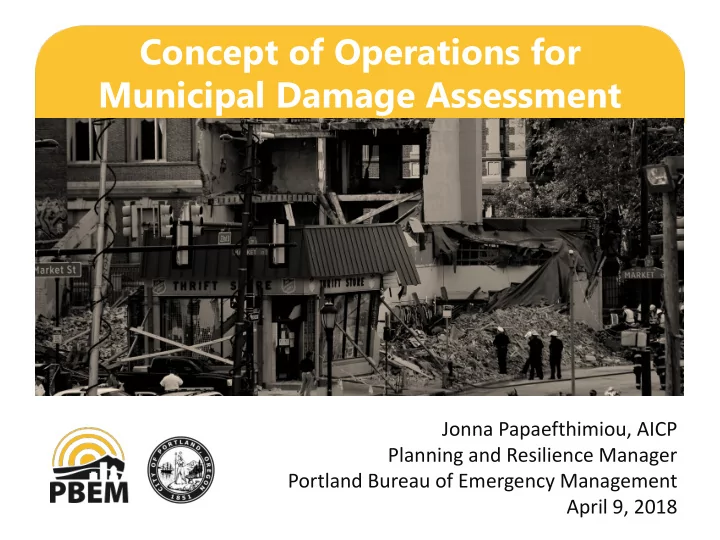

Concept of Operations for Municipal Damage Assessment Jonna Papaefthimiou, AICP Planning and Resilience Manager Portland Bureau of Emergency Management April 9, 2018
Development of Portland Damage Assessment Plan collaborators Written by Portland Emergency Management staff in consultation with other City bureaus and Multnomah County.
Purpose of the Plan A framework Collect and synthesize damage information to: 1. Inform operational response planning, 2. Protect the public from dangerous buildings, 3. Facilitate a disaster declaration, 4. Begin recovery.
Plan Goals • Establish an organizational structure for systematic damage assessment; • Coordinate information sharing among key partners (county, hospitals, schools). • Facilitate damage reporting for homeowners and businesses.
Strategies • Identify critical infrastructure, and • Identify assessment tools and data platform. o Collector App showing ATC-20 form plus monetary damage estimate. o Uploads to WebEOC.
Strategies Collect three layers of information: • Rapid damage assessment : general situational awareness, from any credible source. • Estimated monetary damages : for FEMA declaration, completed by layperson. • Safety inspections (ATC-20, ATC-45) : require qualified building inspector.
“Normal” damage assessment landslide, flooding, fire • First responders do rapid damage assessment. • Safety inspections done in a few hours - days. • Public self-reports lesser damage to homes and businesses via phone or website. • Public agencies tabulate damage in few days-weeks.
“Normal” damage assessment landslide, flooding, fire • Focus on tabulating monetary losses for insurance claims and FEMA disaster declaration. • Use paper and City permit database. • Rely on email to share information.
Catastrophic scenario CSZ earthquake • Normal work disrupted; workforce reduced; travel difficult; first responders overwhelmed. • Email, mobile phones, and City permit database likely not available for some time. • Bureaus activate emergency response and business continuity plans as they are able. • FEMA will likely make a “fly-over” declaration.
Rapid Damage Assessment 0-24 hours • Fire Stations check Fire Management Area and report info to Station 1. • Water bureau deploys damage Assessment Teams and report to bureau incident command post. • Transportation deploys bridge inspection teams and reports to bureau incident command post.
Rapid Damage Assessment 0-24 hours • Emergency Coordination Center staff deploy. • Bureaus activate COOP and report facilities’ status. • ECC staff develop situation status report based on: o Reports from bureau incident command posts, o Media and social media reports, o Information reported to partner agencies (Multnomah County).
Begin Safety Inspections 24-48 hours • Building inspectors rally at ECC and Permit Center and deploy to assess buildings. • Begin with critical structures. • Use Collector App. Fall-back to paper forms. • Inspectors focus in zones where they normally work.
Safety inspections and monetary estimates 24-48 hours • Continue to dispatch damage assessment teams, organized from City ECC. • Direct qualified volunteers to support City DATs. • Request emergency declaration if necessary.
Inspections Continue 2 days-2 weeks • Bureau of Develop Services will activate COOP and begin issuing emergency demo and repair permits. • DATs from other parts of the US will arrive in Portland. • FEMA will establish methods for public to report damage for public assistance.
Recovery 2 weeks - years • Aftershocks will require re-inspection of buildings for months. • Many structures will be demolished or destroyed; many historic structures may be lost.
For future development plan update • Clarify / expand who may inspect buildings post- disaster. • Develop operational guides for deploying DATs. • Develop just-in-time training for volunteers. • Learn from damage assessment efforts elsewhere. • Mitigate vulnerable buildings.
Thank you questions? Jonna Papaefthmiou, AICP Planning and Resilience Manager Portland Bureau of Emergency Management 503-823-3809 | jonnap@portlandoregon.gov
Recommend
More recommend